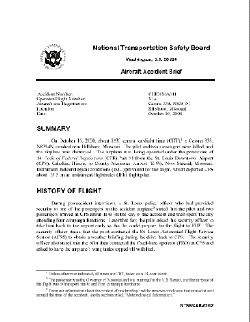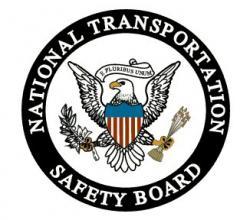Spatial Disorientation, Turbulence, Vacuum Problems
Conspired
 The National Transportation Safety Board has
released its final report on the October 16, 2000 crash of a Cessna
335 in Hillsboro, Missouri. The accident took the lives of Missouri
governor Mel Carnahan, his son Randy, and his campaign aide, Chris
Sifford ("Missouri Governor Killed in Twin Cessna Crash," 10-18-00;
"Gov. Carnahan's Plane had Gyro Work Just Before Accident,"
10-23-00, ANN).
The National Transportation Safety Board has
released its final report on the October 16, 2000 crash of a Cessna
335 in Hillsboro, Missouri. The accident took the lives of Missouri
governor Mel Carnahan, his son Randy, and his campaign aide, Chris
Sifford ("Missouri Governor Killed in Twin Cessna Crash," 10-18-00;
"Gov. Carnahan's Plane had Gyro Work Just Before Accident,"
10-23-00, ANN).
[Excerpt] The pilot responded, "we got our hands full right
now." At 1921:08, the controller stated, "uh roger you in some sort
of difficulty." The pilot responded, "we got a primary attitude
indicator that's not uh reading properly having to try and fly off
of copilot [the right-side attitude indicator]."
...The pilot's estimated total actual instrument flight time was
about 87.6 hours, of which 22.4 hours were in a Cessna 335.21 His
estimated total simulated instrument flight time was about 65.2
hours, of which 1 hour was in a Cessna 335. Records indicate that
the pilot's most recent instrument proficiency checkride was on
September 21, 1999. Flights recorded in the pilot's logbook that
contained the remark "partial panel flight" totaled to about 12.3
hours,22 none of which were in a Cessna 335.
...After first reporting that the primary attitude indicator was
malfunctioning, the pilot continued flight for about 11 minutes,
including two controlled heading changes, indicating that the pilot
had functioning cockpit instruments and that he could control the
airplane. Further, in the event that an instrument malfunction
occurs, instrument flight rules (IFR)-qualified pilots are trained
to use other relevant instruments, which evidence indicates were
operating on the accident airplane (the right-side attitude
indicator). Therefore, the loss of the primary attitude indicator
alone does not explain why the pilot lost control of the airplane
and crashed.
 However, the right-side attitude indicator was not
large and would have been several feet to the right of the pilot.
Therefore, using the right-side attitude indicator would have
resulted in the pilot making frequent, rapid head movements to
cross-check that instrument with the other instruments. The pilot's
head movements most likely caused him to experience spatial
disorientation. Further, the rain conditions in which the pilot was
maneuvering would have increased the noise level in the cockpit,
and the presence of turbulence would have made it more difficult to
control the airplane with failed instrumentation, both of which
would likely have exacerbated the pilot's spatial
disorientation.
However, the right-side attitude indicator was not
large and would have been several feet to the right of the pilot.
Therefore, using the right-side attitude indicator would have
resulted in the pilot making frequent, rapid head movements to
cross-check that instrument with the other instruments. The pilot's
head movements most likely caused him to experience spatial
disorientation. Further, the rain conditions in which the pilot was
maneuvering would have increased the noise level in the cockpit,
and the presence of turbulence would have made it more difficult to
control the airplane with failed instrumentation, both of which
would likely have exacerbated the pilot's spatial
disorientation.
...The National Transportation Safety Board determines that the
probable cause of this accident was the pilot's failure to control
the airplane while maneuvering because of spatial disorientation.
Contributing to the accident were the failure of the airplane's
primary attitude indicator and the adverse weather conditions,
including turbulence.
**** 10/17/2000 Preliminary Accident/Incident Data Record 1
****
A. Type: A Mid Air: N Missing: N Entry date: 10/17/2000 From:
CENTRAL REGION OPERATIONS CENTER
B. Reg. No.: 8354N M/M: C335 Desc: Activity: Unknown Phase: Climb
GA-A/C: General Aviation Descr: AIRCRAFT REPORTED GYRO PROBLEM AT
6500 FT, SHORTLY THEREAFTER ACFT DISAPPEARED FROM RADAR, 3 FATAL,
FESTUS, MO WX: UNKN Damage: Unknown

C2. Injury Data:
# Crew: 1 Fat: 1 Ser: 0 Min: 0 Unk:
# Pass: 2 Fat: 2 Ser: 0 Min: 0 Unk:
# Grnd: Fat: 0 Ser: 0 Min: 0 Unk:
D. Location. City: FESTUS State: MO Country: US
E. Event Date: 10/16/2000 Time: 0032
F. Invest Coverage. IIC: Reg/DO: CE05 DO City: KANSAS CITY
G. Flt Handling. Dep Pt: CAHOKIA, IL Dep Date: 10/15/2000 Time:
Dest: NEW MADRID, MO Last Radio Cont: 15NW OF FESTUS Flt Plan: IFR
Last Clearance: UNKN WX Briefing: U Other: AAI IIC:
N-number: N8354N
Aircraft Serial Number: 335-0063
Aircraft Manufacturer: CESSNA
Model: 335
Engine Manufacturer: CONT MOTOR
Model: TSIO-520 SER
Aircraft Year: 1980
Owner Name: CARNAHAN HICKLE & CALVERT LLC DBA
Owner Address: ROLLA, MO, 65402-0698
Registration Date: 19-Oct-1998
Airworthiness Certificate Type: Standard
Approved Operations: Normal
 Airborne 08.22.25: ARC Spinoff, Nat'l Championship Air Races, Hawkins Accident
Airborne 08.22.25: ARC Spinoff, Nat'l Championship Air Races, Hawkins Accident Airborne 08.27.25: Air Race Tkt Discounts, Europe AvGas, Deportation Flights?
Airborne 08.27.25: Air Race Tkt Discounts, Europe AvGas, Deportation Flights? Airborne Affordable Flyers 08.28.25: Midwest Av Expo, Vickers, Air Race Classic
Airborne Affordable Flyers 08.28.25: Midwest Av Expo, Vickers, Air Race Classic Aero-News: Quote of the Day (08.30.25)
Aero-News: Quote of the Day (08.30.25) ANN's Daily Aero-Term (08.30.25): Low Approach
ANN's Daily Aero-Term (08.30.25): Low Approach





